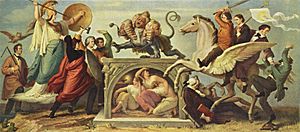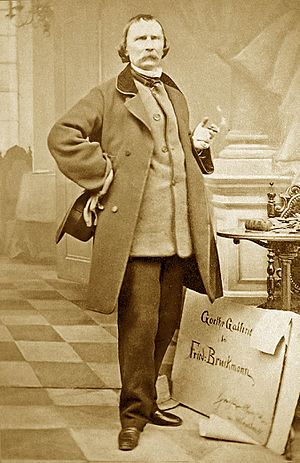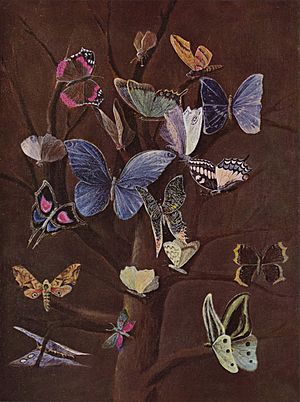Wilhelm von Kaulbach facts for kids
Wilhelm von Kaulbach (born October 15, 1805 – died April 7, 1874) was a famous German painter. He was best known for his large wall paintings, called murals. He also illustrated books. Many of his beautiful murals can still be seen on buildings in Munich, Germany. He was part of a group of artists known as the Düsseldorf school of painting.
Contents
Biography
Early Life and Education
Wilhelm von Kaulbach was born in Bad Arolsen, a town in Waldeck, Germany. His father was an artist who painted, engraved, and worked as a goldsmith. His family was very poor. Wilhelm and his sister sometimes had to accept old bread from farmers. This experience might have inspired his early painting, The Fall of Manna in the Wilderness.
When he was seventeen, Wilhelm got a chance to study art. The sculptor Rauch helped him get into the Düsseldorf Academy of Fine Arts. This academy was becoming very famous under its director, Peter von Cornelius. Kaulbach became one of Cornelius's best students. He faced many challenges, even hunger, but he never gave up. He was a talented and hardworking young artist. He quickly became a leader among young German artists who wanted to bring art back to life in their country.
Painting Murals in Munich

King Ludwig I of Bavaria wanted to make Munich a center for German art. This gave young Kaulbach a great opportunity. His teacher, Cornelius, was hired to create huge wall paintings, called frescoes, for the Glyptothek museum. Cornelius would draw the designs in Düsseldorf during winter. Then, in summer, he would go to Munich with his best students, including Kaulbach. There, they would paint the designs onto the museum walls.
In 1824, Cornelius became the director of the Munich Academy of Fine Arts. Kaulbach, who was not yet twenty, moved to Munich permanently. He worked hard on public art projects and took on his own commissions. In 1849, when Cornelius moved to Berlin, Kaulbach took over as director of the academy. He held this important position until he died.
Kaulbach became very skilled at creating large-scale wall decorations, like the masters of the Middle Ages. He brought painting and architecture together again. He was incredibly creative, like artists such as Raphael and Michelangelo. Under Cornelius's guidance, Kaulbach designed many frescoes for new buildings in Munich between 1825 and 1828. These included "Apollo and the Muses" for the Odeon building. He also created designs based on poems by Klopstock, Goethe, and Wieland for the royal palace. For Duke Max's palace, he painted classical scenes from the story of Amor and Psyche. He also added many symbolic figures to the arcades of the palace garden.
One of his early famous works was Narrenhaus, which showed scenes from a madhouse near Düsseldorf. He also created illustrations for Reineke Fuchs, a popular story. His next major work was The Battle of the Huns, also known as Spectre Battle. This painting showed the legend of a battle continuing in the air between the spirits of Huns and Romans. It was a huge painting that showed his talent for symbolic art. Count Raczynski asked him to paint it in sepia, and Kaulbach finished it in 1837. The king of Saxony offered him a job as director of the Dresden academy, but Kaulbach chose to stay in Munich.
Kaulbach's works often showed his sense of humor and love for satire. He was very good at showing different characters. Sometimes, his art could be a bit over-the-top, like in his satire "The Pigtail Age," a fresco outside the New Pinakothek. However, these moments came from his strong artistic power. Kaulbach tried to paint like ancient Greek and Italian artists, but his style was more like German masters such as Dürer and Holbein. During this time in Munich, many artworks were created quickly. Kaulbach became very good at covering large walls and canvases.
Illustrating the History of Mankind
Kaulbach had mostly worked with frescoes. To prepare for a new oil painting for the New Pinakothek, he spent time in Venice and a year in Rome. He finished this oil painting in 1846. Around the same time, he began his famous designs for the Neues Museum in Berlin. These designs showed important moments in human history. His students helped him paint them, and they were finished in 1860.
These six large frescoes included:
- The Tower of Babel
- Homer and the Greeks
- The Destruction of Jerusalem
- The Battle of the Huns (This painting inspired a famous piece of music by Liszt in 1857.)
- The Crusaders at the gates of Jerusalem
- The Age of the Reformation
Each of these main paintings was about 30 feet long and featured over one hundred figures larger than life. They were surrounded by more than twenty smaller paintings. The idea was to show the main forces of civilization around these historical events. This included symbolic figures of architecture and other arts, science, and important lawgivers like Moses. Even Frederick the Great was included. These impressive and educational paintings were placed on the grand staircase of the Neues Museum in Berlin. A special wall surface was used, and a technique called "water-glass" helped the paintings last a long time. Sadly, the staircase was badly damaged during World War II, and only small parts of Kaulbach's work remain today.
Kaulbach's clear and dramatic style also made him a popular book illustrator. He created engraved designs for a Shakespeare gallery, a Goethe gallery, and a large edition of the Gospels. Some people thought that Kaulbach tried to paint subjects that were too big for him. However, in works like The Destruction of Jerusalem and The Battle of the Huns, Kaulbach showed true creative imagination. He was like a storyteller, showing characters and actions in a powerful way. His paintings could be very dramatic, but they had a huge impact. The original drawings for these works, called cartoons, were often even better than the final paintings. He created these when he was around thirty years old, at the peak of his artistic skill.
Later Works and Legacy
In his later years, Kaulbach's style didn't change much. His final works often showed an exaggerated version of his earlier characteristics. His series of designs illustrating Goethe's works were very popular. They were dramatic and appealed to what people liked. His huge painting, Sea Fight at Salamis, which was over 30 feet long, showed his usual imagination. The way he painted was still grand and strong. However, in this exciting battle scene, he sometimes lost a sense of calm and naturalness.
Kaulbach was a strong Protestant. This caused some disagreements with his former teacher, Cornelius, who was a committed Catholic. This difference was clearly shown in Kaulbach's painting Don Pedro de Arbuez, the Inquisitor. This painting appeared around the time of the ecumenical council (1869-70) and caused a lot of discussion.
Before he died, Kaulbach was working on a large drawing of The Deluge (the great flood). He had also finished his painting of St. Michael, the Patron Saint of Germany. In this painting, St. Michael looks like a triumphant heavenly messenger. Napoleon III, his son, and several Jesuits are shown cowering at St. Michael's feet.
Wilhelm von Kaulbach lived at Obere Garten Gasse 16½ in Munich around 1850. In 1870, he was chosen as an honorary member of the American Academy of Arts and Sciences. He passed away on April 7, 1874, in Munich and is buried in the Alter Südfriedhof cemetery there. His son, Hermann, also became a well-known painter.
Artistic Style
Kaulbach's artistic style was a mix of different influences. In his painting Age of Homer, the figures and style came from ancient Greek sculptures and vases. Then, in The Tower of Babel, the strictness of ancient art gave way to the softer style of the Italian renaissance. In The Crusaders, his painting became more like modern romanticism. Even though his art combined many styles, he blended them so well that they looked like they came from one mind.
However, people started wanting new things in art. So, in his later years, Kaulbach's popularity went down. He saw new art movements like naturalism and realism becoming popular. He is perhaps most remembered for his unique way of showing themes like death, destruction, and madness in his art.
Images for kids
See also
 In Spanish: Wilhelm von Kaulbach para niños
In Spanish: Wilhelm von Kaulbach para niños





